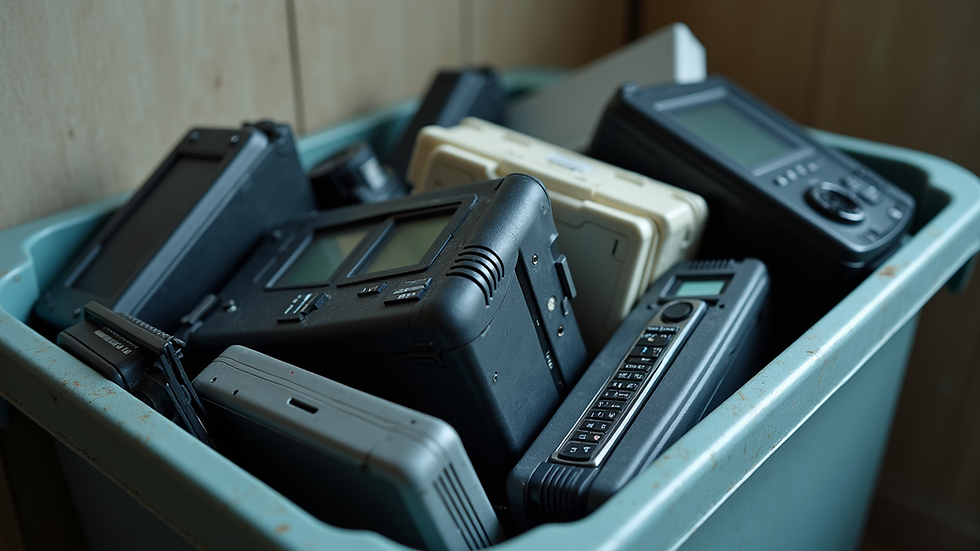Expert IT Equipment Recycling: Trusted & Environmentally Conscious
- EcoCycleIT
- Jul 22
- 5 min read
In today's fast-paced digital world, technology is constantly evolving. New devices and equipment are released every year, making older models obsolete. This rapid turnover creates a significant challenge: what to do with outdated IT equipment? Disposing of electronic waste (e-waste) improperly can harm the environment and human health. However, expert IT equipment recycling offers a solution that is both responsible and sustainable.
In this blog post, we will explore the importance of IT equipment recycling, the benefits it brings, and how to choose a trusted recycling partner.
The Importance of IT Equipment Recycling
E-waste is one of the fastest-growing waste streams globally. According to the Global E-waste Monitor, around 53.6 million metric tons of e-waste were generated in 2019, and this number is expected to rise.
Improper disposal of e-waste can lead to harmful substances, such as lead, mercury, and cadmium, leaching into the soil and water. These toxic materials can have severe consequences for both the environment and public health.
Recycling IT equipment helps mitigate these risks. By recycling, we can recover valuable materials, reduce pollution, and conserve natural resources.
Benefits of Expert IT Equipment Recycling
Environmental Protection
One of the most significant benefits of recycling IT equipment is environmental protection. When electronic devices are recycled, harmful materials are safely processed, preventing them from entering landfills.
Recycling also conserves natural resources. For example, recycling one million laptops can save the energy equivalent to the electricity used by 3,657 homes in a year.
Economic Advantages
Recycling IT equipment can also have economic benefits. By recovering valuable materials, such as gold, silver, and copper, recycling can create jobs and stimulate local economies.
Additionally, businesses can save money by recycling their old equipment instead of paying for disposal. Many recycling companies offer free or low-cost services, making it a cost-effective solution.
Data Security
When disposing of IT equipment, data security is a top concern for businesses. Expert recycling companies ensure that all data is securely wiped from devices before they are recycled.
This process protects sensitive information from falling into the wrong hands. Many recycling companies provide certificates of data destruction, giving businesses peace of mind.
How to Choose a Trusted Recycling Partner
Choosing the right recycling partner is crucial for ensuring that your IT equipment is recycled responsibly. Here are some tips to help you make an informed decision:
Look for Certifications
When selecting a recycling company, check for certifications. Look for companies that are certified by organizations such as R2 (Responsible Recycling) or e-Stewards. These certifications ensure that the company follows strict environmental and data security standards.
Research Their Practices
Take the time to research the recycling practices of potential partners. A reputable recycling company should have transparent processes for handling e-waste. They should be able to explain how they recycle materials and what happens to the equipment after it is collected.
Read Reviews and Testimonials
Customer reviews and testimonials can provide valuable insights into a recycling company's reputation. Look for feedback from other businesses that have used their services. Positive reviews can indicate a reliable and trustworthy partner.
Ask About Data Security Measures
Data security is a critical aspect of IT equipment recycling. Ensure that the recycling company has robust data destruction processes in place. Ask about their methods for wiping data and whether they provide certificates of destruction.
Consider Local Options
Whenever possible, choose a local recycling partner. Local companies are often more invested in their communities and may offer more personalized service. Additionally, working with a local company can reduce transportation emissions, further benefiting the environment.
The Recycling Process Explained
Understanding the recycling process can help demystify how IT equipment is handled. Here is a step-by-step overview of what typically happens when you recycle your IT equipment:
Collection
The first step in the recycling process is collection. Many recycling companies offer pickup services for businesses, making it easy to dispose of old equipment.
Sorting
Once collected, the equipment is sorted based on its type and condition. Working devices may be refurbished and resold, while non-working items are dismantled for parts.
Data Destruction
Before any equipment is recycled, data destruction is performed. This step ensures that all sensitive information is securely wiped from devices.
Recycling
After data destruction, the equipment is processed for recycling. Valuable materials are extracted, and hazardous components are disposed of safely.
Resale or Disposal
Finally, the recycled materials are either resold to manufacturers or disposed of responsibly. This step closes the loop on the recycling process, ensuring that materials are reused rather than wasted.
Real-World Examples of Successful IT Equipment Recycling
Many companies have successfully implemented IT equipment recycling programs. Here are a few examples:
Dell's Recycling Program
Dell has a comprehensive recycling program that allows customers to return old devices for free. The company has committed to recycling an equivalent product for every product sold. This initiative not only reduces e-waste but also promotes a circular economy.
Apple’s Trade-In Program
Apple offers a trade-in program that allows customers to exchange their old devices for credit towards new purchases. The company ensures that all returned devices are either refurbished or recycled responsibly.
HP’s Planet Partners Program
HP’s Planet Partners program provides businesses with an easy way to recycle their old printers and cartridges. The program emphasizes sustainability and aims to reduce the environmental impact of printing.
The Future of IT Equipment Recycling
As technology continues to advance, the need for responsible IT equipment recycling will only grow. Innovations in recycling processes and materials recovery will play a crucial role in shaping the future of e-waste management.
Emerging technologies, such as artificial intelligence and automation, are being integrated into recycling operations. These advancements can improve efficiency and increase the recovery of valuable materials.
Additionally, as more companies recognize the importance of sustainability, the demand for expert IT equipment recycling will likely rise. Businesses that prioritize responsible recycling will not only contribute to environmental protection but also enhance their brand reputation.
Taking Action: Your Role in IT Equipment Recycling
As individuals and businesses, we all have a role to play in promoting responsible IT equipment recycling. Here are some steps you can take:
Educate Yourself and Others
Stay informed about the importance of e-waste recycling and share this knowledge with your colleagues and friends. Awareness is the first step toward making a positive impact.
Implement a Recycling Program
If you run a business, consider implementing an IT equipment recycling program. Partner with a trusted recycling company and encourage employees to participate.
Dispose of E-Waste Responsibly
When it comes time to dispose of your old devices, do so responsibly. Avoid throwing them in the trash and instead seek out a certified recycling partner.
Advocate for Sustainable Practices
Support companies and initiatives that prioritize sustainability. By choosing to work with environmentally conscious businesses, you can contribute to a greener future.
A Greener Tomorrow Awaits
In conclusion, expert IT equipment recycling is not just a trend; it is a necessity for a sustainable future. By understanding the importance of recycling, choosing trusted partners, and taking action, we can all contribute to a healthier planet.
As technology continues to evolve, let us embrace responsible recycling practices that protect our environment and promote a circular economy. Together, we can create a greener tomorrow for generations to come.




Comments